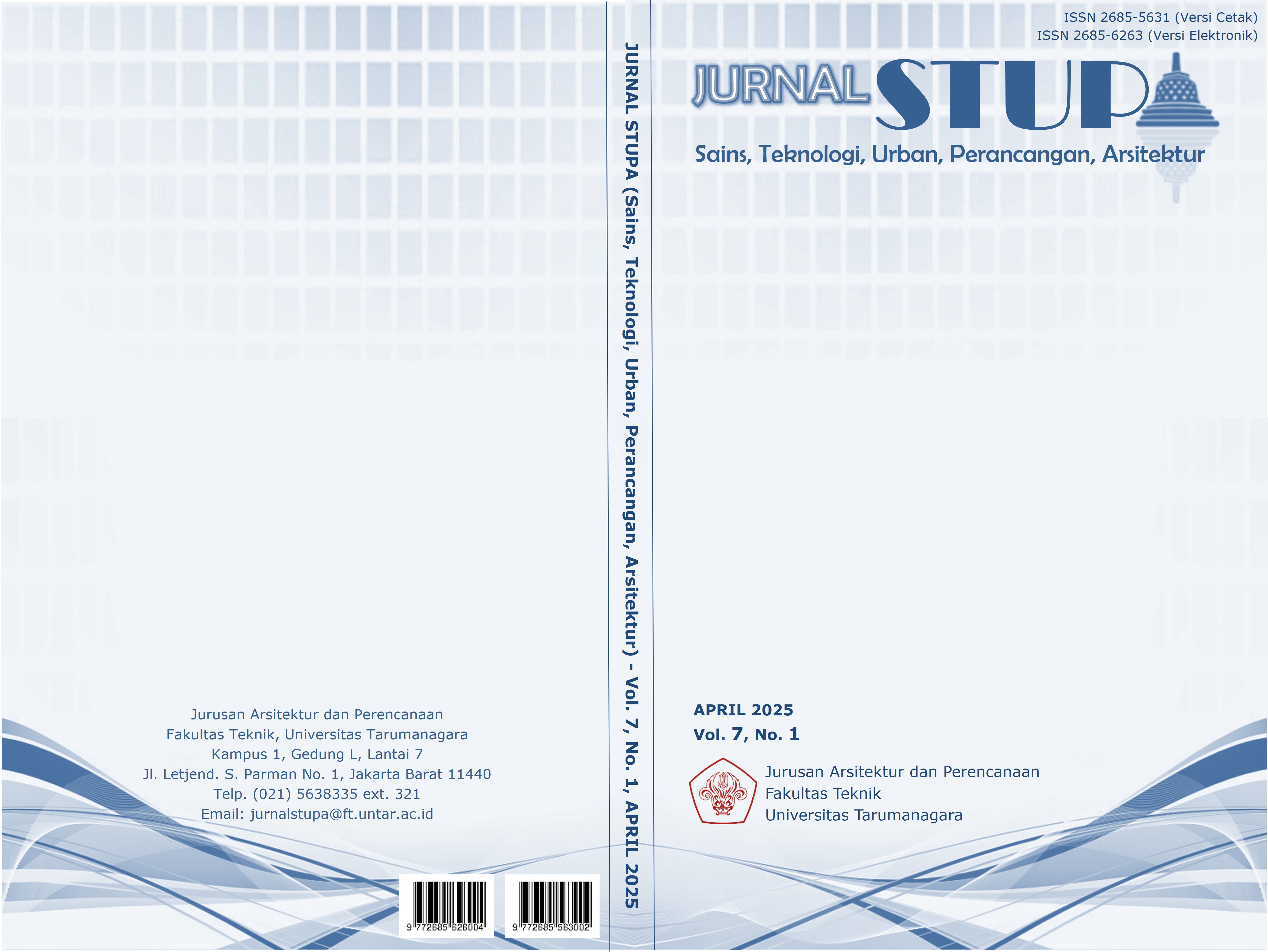PERANCANGAN PUSAT REKREASI URBAN BERBASIS KOMUNITAS DI GLODOK DENGAN PENDEKATAN PERILAKU
Main Article Content
Abstract
In modern times and the increasing human population, humans need land and space for activities, but on the other hand, the land and open space needed is increasingly limited, which also makes human activities limited. The Glodok area is a dense area, in the corners of the Glodok area there are buildings that are degraded or abandoned and left so that the land cannot be utilized optimally for human activities. Meanwhile, the Kebon Torong field, which is a community space for the Glodok community, is threatened with being evicted to be replaced with health facilities, so that the Glodok community loses its community space for exercise and recreation. Therefore, this project is aimed at re-accommodating the people of Glodok so they can exercise as well as have recreation and become a place of entertainment for the community by rebuilding abandoned or degraded buildings so that the land can be reused. This community space can also be a space for collaboration between generations of each age group so that a sense of togetherness is maintained. By presenting recreation and fitness programs that draw from the habits and behavior of the surrounding community, which includes recreation areas, commercial areas and community areas. This research uses qualitative and quantitative methods.
Keywords: behavior; community; generation; recreation; space
Abstrak
Di zaman modern serta meningkatnya populasi manusia membuat manusia membutuhkan lahan dan ruang untuk beraktivitas tetapi disisi lain lahan dan ruang terbuka yang dibutuhkan semakin terbatas, itu juga yang membuat aktivitas manusianya menjadi terbatas. Kawasan Glodok merupakan kawasan yang padat, di sudut-sudut kawasan Glodok terdapat bangunan-bangunan yang mengalami degradasi atau terbengkalai yang dibiarkan membuat lahannya tidak dapat dimanfaatkan secara maksimal untuk aktivitas manusia. Sementara itu lapangan Kebon Torong yang merupakan ruang komunitas bagi komunitas Glodok terancam akan digusur untuk digantikan dengan fasilitas kesehatan, sehingga komunitas Glodok kehilangan ruang komunitasnya untuk berolahraga sekaligus berekreasi. Oleh karena itu proyek ini ditujukan untuk mewadahi kembali masyarakat Glodok agar dapat berolahraga sekaligus berekreasi dan menjadi tempat hiburan bagi komunitas dengan membangun kembali bangunan yang terbengkalai atau mengalami degradasi agar lahannya dapat dimanfaatkan kembali. Ruang komunitas ini juga bisa menjadi ruang kolaborasi antar generasi dari setiap kelompok usia sehingga rasa kebersamaannya tetap terjaga. Dengan menghadirkan program rekreasi dan kebugaran mengambil dari kebiasaan dan perilaku komunitas sekitar, yaitu mencakup area rekreasi, area komersil dan area komunitas. Penelitian ini menggunakan metode kualitatif dan kuantitatif.
Article Details

This work is licensed under a Creative Commons Attribution-NonCommercial-ShareAlike 4.0 International License.
This work is licensed under a Jurnal Sains, Teknologi, Urban, Perancangan, Arsitektur/ STUPA Creative Commons Attribution-NonCommercial-ShareAlike 4.0 International LicenseReferences
Andini, D. A., & Dewi, L. (2022). Development of Cultural Tourism in Glodok China Region. INTERNATIONAL JOURNAL OF ECONOMICS,MANAGEMENT, BUSINESSAND SOCIAL SCIENCE (IJEMBIS), 2(3), 427-440. Retrieved from https://cvodis.com/ijembis/index.php/ijembis
Budianto, V., Tadeus, R. Q., Djaukar, J., Ekomadyo, A. S., & Sugangga, M. (2023, December). An evaluation of the alleys of Glodok and its market culture. Jurnal Teknik Arsitektur, 8(3), 395-404. doi:10.30822
Fananiar, F. A., Pangesti, J. D., & Prasetiyo, H. (2021). Pengaruh Kondisi Lingkungan Terhadap Bentuk Bangunan Arsitektur (Vol. 11). Surabaya: JURNAL ARSITEKTUR.
Harisdani, D. D., & Zafirah, N. (2021). Governmental Lodging and Recreation with The Approach of Tropical Architecture. International Journal of Architecture and Urbanism, 05(02), 172-181. doi:10.32734/ijau.v5i2.6836
Indriyati, S. A. (2022, August). Behavior Approach for Designing in Architecture. International Journal of Innovative Science and Research Technology, 7(8), 865-869. Retrieved from https://www.bing.com/ck/a?!&&p=584bbe3512adb40aJmltdHM9MTcxMTc1NjgwMCZpZ3VpZD0wN2UyNjAyNS03MmI4LTYxM2MtMDU1Zi02ZTFmNzM3MzYwMzUmaW5zaWQ9NTE5NA&ptn=3&ver=2&hsh=3&fclid=07e26025-72b8-613c-055f-6e1f73736035&psq=Behavior+Approach+for+Designing+in+Architecture&
Leonardo, dan Ratnaningrum, D. (2020, Oktober). RUANG KOMUNITAS TIONGHOA DI GLODOK. Jurnal Stupa, 2, 1847-1858. doi:10.24912
Li, Y., Ming, X., Zhao, H., Li, W., dan Long, Y. (2023). Identifying abandoned buildings in shrinking cities with mobile sensing images (Vol. 2). Beijing: Li et al. Urban Informatics. doi:https://doi.org/10.1007/s44212-023-00025-5
Oktarina, F., & Kurniawan, K. R. (2021). The History of Jakarta's Chinatown: The Role of the City Gate as a Transition Area and a Starting Point in the Spatial Transformation from the First Chinatown to the Renewal Phase. SPFA Journal, 5, 1-24. doi:https://doi.org/10.26721/spafajournal.2021.v5.650
Shao, F. Y. (2019). Interior Space Design of Community Activity Center Based on Service Function. Open Journal of Social Sciences, 7, 209-214. doi:https://doi.org/10.4236/jss.2019.75017
Tirta, R. B., dan Lissimia, F. (2020, September 2). KAJIAN PENERAPAN ARSITEKTUR PERILAKU PADA BANGUNAN PASAR IKAN DI MUARA BARU. Jurnal Arsitektur PURWARUPA, 04(2), 55-62. Retrieved from https://www.bing.com/ck/a?!&&p=2843da5035f01655JmltdHM9MTcxMTQ5NzYwMCZpZ3VpZD0wN2UyNjAyNS03MmI4LTYxM2MtMDU1Zi02ZTFmNzM3MzYwMzUmaW5zaWQ9NTIwNA&ptn=3&ver=2&hsh=3&fclid=07e26025-72b8-613c-055f-6e1f73736035&psq=KAJIAN+PENERAPAN+ARSITEKTUR+PERILAKU+PADA+BANGUN



